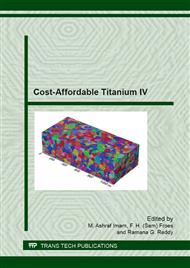p.44
p.57
p.67
p.73
p.86
p.92
p.103
p.109
p.114
The Effects of Lubrication on the Density Gradient of Titanium Powder Compacts
Abstract:
In order to investigate the role of lubrication on the density gradient of titanium powder, a coloured layer method was employed. HDH titanium powder mixed with 0-1wt% stearic acid (SA) or magnesium stearate (MgSt) was cold compacted under different pressures. Coloured and uncoloured powders were used to give different layers in the die before compaction. The in situ density of different sections was calculated by measuring the height of the different layers. By using this method, the role of lubrication on the density gradient of titanium powder was experimentally measured. It was found that 0.3wt% of lubricant significantly improves the density variation, but further additions give only a slight improvement. An addition of 0.6wt% of SA provides an optimum density variation. The sintering results show that by using a very small amount of lubricant during processing there are no significant amounts of residual contaminants remaining in the Ti alloy.
Info:
Periodical:
Pages:
86-91
Citation:
Online since:
May 2013
Authors:
Keywords:
Price:
Сopyright:
© 2013 Trans Tech Publications Ltd. All Rights Reserved
Share:
Citation:


